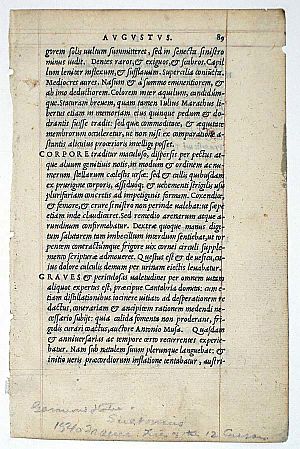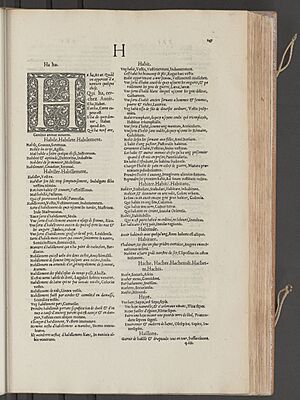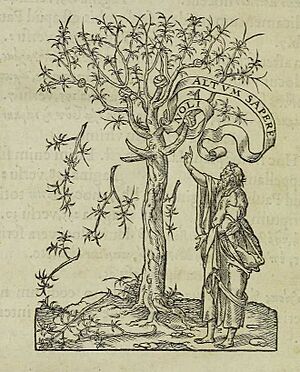Robert Estienne facts for kids
Quick facts for kids
Robert Estienne
|
|
|---|---|
Portrait of Robert Estienne from Hendrik Hondius's Icones virorum nostra patriumque memoria illustrium (1599)
|
|
| Born |
Robert Estienne
1503 |
| Died | 7 September 1559 (aged 55–56) |
| Nationality | French, Genevan (since 1556) |
| Other names | Robert Stephanus, Robert Stephens, Roberti Stephani |
| Occupation | Humanist, printer, publisher |
| Known for | Publishing the Thesaurus linguae latinae, creating the most common chapter and verse divisions for the Bible |
Robert I Estienne (French: [etjɛn]; 1503–7 September 1559), also known as Robertus Stephanus in Latin, was a famous printer in Paris during the 1500s. He took over the Estienne print shop after his father, Henri Estienne, passed away. Robert Estienne printed and republished many classic books. He also printed Greek and Latin versions of the Bible.
He was known as "Printer to the King" for his skills in Latin, Hebrew, and Greek. Estienne's most important work was the Thesaurus linguae latinae. This huge Latin dictionary is still seen as the basis for modern Latin dictionaries. He was also the first to print the New Testament with the standard numbered verses we use today.
Robert Estienne grew up as a Catholic. Later in his life, he became a Protestant. Many of his Bibles included notes that upset Catholic thinkers at the Sorbonne in Paris. They tried to stop his work. Because of these problems, Estienne and his family moved to Geneva. There, he could print freely without being censored. He published many works by John Calvin. In 1556, he became a citizen of Geneva. He died there on September 7, 1559.
Two of Estienne's four sons became skilled printers. One of them, Henri Estienne, continued the family's printing business. Robert Estienne helped make the 1500s a "Golden Age of French Typography" (fancy printing).
Contents
Biography
Early Life and Printing Start
Robert Estienne was born in Paris in 1503. He was the second son of Henri Estienne, a well-known printer. Robert learned Latin, Greek, and Hebrew from a young age. When his father died in 1520, the family printing business was run by his father's partner, Simon de Colines. Colines also married Robert's mother.
In 1526, Robert Estienne took control of his father's print shop. Colines then started his own printing business nearby. They divided the printing equipment and supplies fairly. Scholars believe Estienne and Colines respected each other and might have even shared fonts and materials.
Estienne's first independent printing project was a Latin Bible in 1524. He looked for old handwritten copies of the Bible in Paris. He had already printed a New Testament. Some small changes he made to the text caused arguments with the theology (religious study) teachers. This was the start of many disagreements between him and them. Around this time, he joined the Reformed Church.
In 1526, Estienne married Perrette Badius. Her father, Josse Badius Ascensius, also owned a print shop. This gave Estienne more resources for his printing. After her father died in 1535, Estienne combined the Estienne and Badius printing businesses. His first full Latin Bible, called Biblia, was published in 1527.
To earn money and build his reputation, Estienne also printed many small, affordable educational books. These were called octavos. They featured works by famous scholars like Cicero. Estienne mostly worked as a printer and bookseller. He printed his own books and did not often partner with other printers.
Printing Classic Books
Robert Estienne became known as a "royal typographer" (a printer for the king). He made his print shop famous by publishing many grammar books and schoolbooks. He also printed works by important classical writers like Dio Cassius, Cicero, and Julius Caesar.
In his first 15 years, Estienne focused on five main Latin authors: Cicero, Terence, Plautus, Pliny, and Virgil. He also printed works by Horace. From 1541 to 1545, he nearly tripled the number of authors he published. Some historians think he printed more classic books to balance the problems he was having with the Catholic Church over his Bibles.
Many of Estienne's classic editions, especially the Greek ones, were known for their beautiful printing. The Greek typefaces (fonts) he used were made by Claude Garamond. Estienne was the first printer allowed to use the grecs du roi, or the king's Greek typefaces. These were used to print the first edition of Roman History.
In the 1530s, Estienne's printing was among the first in France to use apostrophes and grave and acute accents. He also helped adapt the Aldine roman type (a style of font) in France.
Creating Dictionaries
Robert Estienne was one of the best printers of his time. He was asked to create a dictionary from the best Latin writings. In 1531, he published Thesaurus linguae latinae. Many scholars believe this dictionary is the basis for modern Latin dictionaries. It also made Estienne the "father of French dictionary-making."
He worked on this dictionary for two years. The first version was 964 pages long. He improved it in 1536 and again in 1543, making it three volumes. This dictionary is seen as his "greatest monument of Latin scholarship."
From his work on the Thesaurus linguae latinae, he also published other dictionaries. These included Dictionarium latino-gallicum in 1538 and Dictionaire francoislatin in 1540. His dictionaries were better than others at the time. They only included words from classic writings and checked words for correctness. They also used a consistent alphabetical order.
In the 1540s, he started publishing shorter school dictionaries. Many of these were translated into other languages, like German. He also published several editions of Alphabetum graecum (Greek Alphabet) from 1528 to 1580. This book showed how Greek was written during the Renaissance.
Printing Religious Texts
Robert Estienne began printing Latin Bibles in 1528. His first Greek New Testament was printed in 1546. The third and most important Greek New Testament he printed was the Editio Regia (Royal Edition) in 1550. He made it for King Henri II. The Greek font used in this edition, made by Garamond, became very popular for printers across Europe. This 1550 version became known as the Textus Receptus, which was the standard text for many years.
In his 1551 edition of the Bible, Estienne included Erasmus's Latin translation and the Vulgate (a Latin version of the Bible). In this edition, Estienne was the first to divide the New Testament into both chapters and verses. This is how Bibles are still organized today.
Estienne also printed two editions of the Hebrew Bible. He collected Vulgate manuscripts (old handwritten copies) in Paris. He printed several editions of the Vulgate throughout his career. In his 1532 edition, he placed the book of Acts between the Gospels and Paul's letters. This is the standard order in most Bibles today. Before this, Acts was usually found at the end.
In 1539, Estienne received the special title of "Printer to the King" for Latin and Hebrew. Later, he also received it for Greek. This made the Sorbonne (theology faculty in Paris) angry. Estienne had changed from Catholicism to Protestantism. The Sorbonne did not like the new humanist ideas of the time. They tried to stop Estienne's printing business.
King Francis I of France protected Estienne. The king and Estienne were good friends. Estienne helped Francis I print documents that supported his power. Later, Estienne printed a document explaining how alliances between French royalty, German Protestants, and Turkish royalty could help bring religious peace in Europe. In 1538, King Francis I asked Estienne to give a copy of every Greek book he printed to create the royal library. This became the first copyright library.
However, after Francis I died in 1547, his son Henry II became king. Estienne then moved to Geneva around 1550. He took his printing materials with him, including his Greek typefaces made by Garamond.
Life in Geneva
When Robert Estienne arrived in Geneva, he published a defense against the Sorbonne's attacks in 1552. It was called his Réponse. He first published it in Latin, then translated it into French. The main idea of his Réponse was that the Sorbonne was very good at convincing or scaring people.
Estienne set up his printing business in Geneva. His brother Charles helped run the family business back in Paris. After Charles died, Robert II (Robert I's son) took over the Paris business. In Geneva, Estienne published the French Bible in 1553. He also printed many of John Calvin's writings, including the Institutio in 1553.
In 1556, he became a citizen of the Republic of Geneva. He died there on September 7, 1559. Estienne's other sons, Henri II and François, helped him run the shop in Geneva. Robert Estienne was one of the most successful printers in his family. He was also one of the best scholars of his time. His work helped make the reign of Francis I known as the "Golden Age of French Typography."
Pressmarks
Robert Estienne used several special symbols, called pressmarks or devices, on his printed books. One of his pressmarks, first seen in 1544, showed an olive branch and a snake wrapped around a spear. This symbol meant wisdom in times of both war and peace. The motto below it meant "to the wise king and the valiant warrior."
Another symbol was called Oliva Stephanorum, or the olive of the Stephens family. It had words from Romans 11:20: Noli altum sapere ("Do not be proud"). Later, it changed to Noli altum sapere, sed time ... ("Be not high-minded but fear"). This symbol showed a man standing by an olive tree. Scholars believe the man is Paul the Apostle, showing the importance of faith. This fits with Estienne's connection to the Protestant Reformation. The olive tree might represent the tree of knowledge. This symbol might have been a subtle criticism of the Catholic thinkers at the Sorbonne for their "lack of humility."
Family Legacy
Robert Estienne wanted all four of his sons to follow in his footsteps and become printers. Two of his sons, Henri and Robert, became successful printers. François (born in 1540) printed in Geneva from 1562 to 1582. He published Bibles in Latin and French, as well as some of Calvin's works.
Robert Estienne II (1530–1570) studied Hebrew, as his father suggested. He was not interested in the Reformation. So, he stayed in Paris instead of going to Geneva with his father. He opened his own printing shop in 1556. In 1563, he earned the title of Typographus regius (Royal Printer). He reprinted his father's first edition of the New Testament in 1568–1569. He also printed the Decalogue (Ten Commandments) in Hebrew and Aramaic in 1566. Robert Estienne II printed Hebrew books for professors in Paris. However, he moved to Geneva in 1569 because he worked for English clients. He died in 1570.
See also






